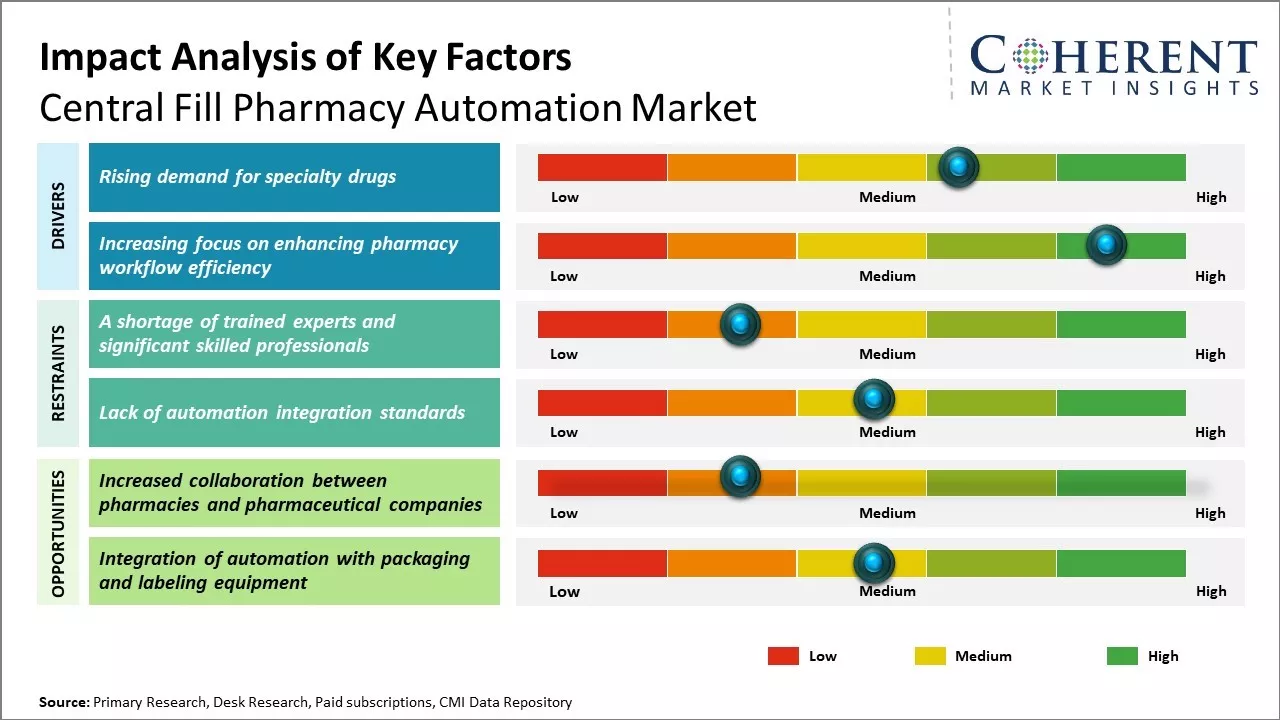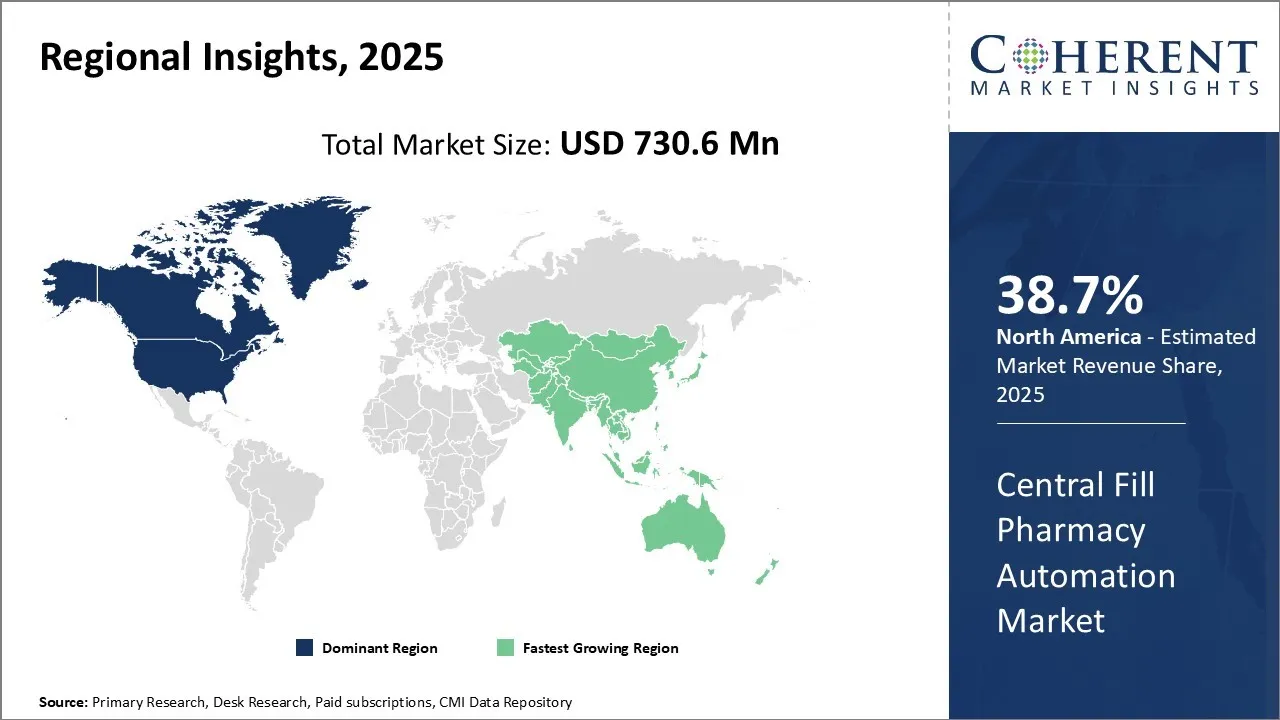Global central fill pharmacy automation market is estimated to be valued at USD 730.6 Mn in 2025 and is expected to reach USD 1,586.0 Mn by 2032, growing at a compound annual growth rate (CAGR) of 11.7% from 2025 to 2032.

To learn more about this report, Download Free Sample
Factors like growing need to reduce medication errors, increased demand for mail-order prescriptions, and focus on improving workflow efficiency are expected to boost demand for central fill pharmacy automation systems. Central fill operations allow pharmacies to consolidate high-volume prescription fulfillment operations at regional or centralized sites that leverage automation technology. This enables pharmacies to offer faster fulfillment turnaround times to patients and healthcare providers while optimizing costs with streamlined workflow processes. Innovations incorporating artificial intelligence, track-and-trace capabilities, and inventory management can also provide opportunities for key market players.
|
Current Events |
Description and its impact |
|
Global Labor Shortages and Pharmacy Staffing Challenges Regulatory Changes and Healthcare Policy Reforms
|
|
|
Regulatory and Healthcare Policy Changes in Developed Markets |
|
|
Technological Innovation and Digitization in Pharmaceutical Supply Chain |
|
|
Global Supply Chain Disruptions and Pharmaceutical Ingredient Shortages |
|
Uncover macros and micros vetted on 75+ parameters: Get instant access to report
Central fill pharmacy automation undeniably boosts operational efficiency and accuracy, but it simultaneously introduces a complex security landscape that is often underestimated.
Central fill systems increasingly depend on interconnected software platforms, cloud-based management, and IoT-enabled robotics. This integration broadens the attack surface considerably. According to a 2023 HIMSS report, healthcare cyberattacks surged by 45% year-over-year, with pharmacy automation systems being prime targets due to their sensitive patient and medication data. Any breach could result in data theft, manipulation of prescription information, or system downtime that disrupts drug dispensing—a direct threat to patient care continuity.
The notorious 2022 ransomware attack on a regional pharmacy network, which forced a week-long shutdown of their central fill operations, exemplifies how devastating such intrusions can be. Despite growing awareness, many pharmacy operators still lack robust cybersecurity protocols tailored to automation platforms, such as end-to-end encryption and real-time anomaly detection.
Automation depends heavily on accurate data flow between pharmacy management systems, inventory databases, and robotic dispensers. Even minor data corruption—whether accidental or malicious—can lead to incorrect medication fulfillment. For example, a single misplaced digit in a dosage instruction routed through automated systems could cause severe patient harm before detection.
Ensuring blockchain-like audit trails and immutable logs is essential but often overlooked. The complexity of multi-vendor integrations further complicates guaranteeing data integrity across the entire workflow.
Physical access control remains a critical yet under-discussed issue. Automation equipment, like robotic dispensers and conveyor belts, must be secured against unauthorized tampering. Insider threats—whether intentional sabotage or negligent behavior—pose a significant risk, especially in facilities where staff are not adequately vetted or trained in security protocols.
With increased regulatory scrutiny under frameworks like the FDA’s DSCSA (Drug Supply Chain Security Act) and HIPAA, central fill automation must ensure strict compliance in tracking, tracing, and protecting patient information. Automated systems must embed security by design, but many legacy platforms struggle to meet these evolving standards without costly upgrades.
The automated medication dispensing system segment is projected to hold the largest market share of 25.8% in 2025, due to its strong impact on reducing medication errors and improving workflow efficiency. These systems enable centralized storage and retrieval of medications, allowing accurate packaging and distribution to individual patients. This centralized process reduces risks associated with manual preparation, while standardizing dosages and labeling to ensure the correct medication reaches the correct patient. Automating tasks like counting, packaging, and labeling allows pharmacies to process more prescriptions with fewer staff, improving productivity and ROI. Centralized verification also ensures compliance with prescription and safety standards, supporting higher quality care. A study published in PubMed demonstrated a notable decrease in medication errors following the implementation of an automated dispensing system in a medical intensive care unit. This is further accelerating the central fill pharmacy automation market.
In terms of application, the inpatient pharmacy segment is projected to account for the largest market share of 40.62% in 2025. This dominance is primarily attributed to the complex and high-risk nature of medication management within hospital settings. Automation technologies—such as centralized fill systems, automated dispensing cabinets (ADCs), inventory management, and robotic dispensing units—play a pivotal role in streamlining pharmacy operations, ensuring medication accuracy, and maintaining regulatory compliance. For instance, in December 2024, Swisslog Healthcare, a prominent provider of robotic medication management solutions, partnered with BD, a global leader in medical technology. This collaboration aims to deliver hospital pharmacies an innovative, end-to-end medication management solution that integrates Swisslog’s robotics with BD’s advanced inventory management and workflow software.

To learn more about this report, Download Free Sample
North America has established itself as the dominant region in the global central fill pharmacy automation market, with an estimated share of 38.7% in 2025. The U.S. leads this growth, driven by widespread adoption of automation systems across retail chains, hospitals, and centralized pharmacy facilities. For example, Publix’s expansion of its central-fill facility in Florida highlights how advanced dispensing technologies streamline operations and enable pharmacists to focus more on patient care Furthermore, North America benefits from a mature healthcare infrastructure and presence of leading global vendors driving innovation and accessibility of cutting-edge systems . Central fill setups enable remote prescription fulfillment across multiple locations, allowing providers to scale operations while improving medication accuracy and cost efficiency.
Asia Pacific is the fastest-growing regional market for central fill pharmacy automation. Countries such as China, India, Japan, and Australia are experiencing rapid growth due to expanding healthcare infrastructure, urbanization, and increased healthcare spending. According to the Economic Survey, the Total Health Expenditure (THE) for FY22 in India was estimated at ₹9,04,461 crore, accounting for 3.8% of GDP and ₹6,602 per capita at current prices. This is further positively influencing the central fill pharmacy market forecast. Apart from this, the rising middle-class populations with growing healthcare needs and higher disposable incomes are driving demand for modernized pharmacy systems. Governments across the region are implementing strategic initiatives to optimize healthcare delivery, enhance efficiency, and ensure medication safety. As automation becomes integral to healthcare modernization, the Asia Pacific market is poised for strong growth through continued investment, local manufacturing, and digital transformation in pharmacy operations.
India’s central fill pharmacy automation market is growing rapidly, supported by government digital health initiatives like the National Digital Health Mission. Automation helps reduce medication errors and improve efficiency in hospitals and pharmacies by streamlining dispensing and inventory management. Rising healthcare demand and urbanization increase the need for centralized, automated systems. However, challenges remain in infrastructure and skilled workforce availability. Overall, India is set for strong growth in pharmacy automation as it modernizes healthcare delivery.
Specialty drugs such as biologics for treating chronic diseases like cancer, rheumatoid arthritis, multiple sclerosis, and others are usually very expensive and require special storage and handling. These often need to be refrigerated or even frozen. With more patients being prescribed such complex specialty drugs for treating various chronic conditions, pharmacies are finding it challenging to efficiently store, pick, pack and ship these sensitive medications while maintaining their integrity. Central fill pharmacy automation facilitates effective inventory management and strict temperature control of specialty drugs, thus, minimizing wastage. The automated systems ensure drugs are picked, verified and packed accurately in thermostabilized environments by robots based on prescription orders. This reduces the risk of temperature excursions which can compromise the potency of drugs. Central fill pharmacies with automation are equipped to cater the growing need for proper handling of specialty medications across a wide geographic region in a cost-effective manner. For instance, in December 2023, according to the data published by TechTarget, Inc., specialty drugs' rising prominence in healthcare necessitates better cost management and patient experiences. Solutions like Optum's Specialty Fusion integrate management across medical and pharmacy benefits, thus, reducing costs. Strategies such as medication synchronization and flexible programs are vital for managing spending and improving experiences amidst expensive specialty drugs' influx.
Pharmacy managers and owners are under constant pressure to improve workflow efficiency and turnaround times as prescription volumes increases. With limited staff and storage space, it is difficult for pharmacies to keep pace with demand while maintaining high accuracy levels. Central fill pharmacy automation addresses this challenge by streamlining the picking, verification, counting and packaging process through robotic and automated solutions. Tasks such as vial capping, tray loading, label verification, and others, which were earlier done manually, can now be rapidly performed 24/7 by machines, freeing up pharmacists and technicians to focus on more complex duties. Automation brings transparency to the filling process and integrates it with inventory and prescription management systems. This improves visibility and allows central fill pharmacies to consistently achieve turnaround targets for dispensing large volumes of orders from partner pharmacies. The systems also optimize pharmacy space utilization through compact designs and vertically-stacked storage of drugs. As a result, central fill pharmacies equipped with automation can fill and ship prescriptions of multiple retail partners simultaneously in an efficient, low error manner. For instance, on February 27, 2024, iA (Intelligent Automation), a company that provides an integrated pharmacy fulfillment platform for retail, health system, and government pharmacies, launched Shared Central Fulfillment, a cloud-based solution enabling pharmacy fulfillment owners to offer centralized services to multiple partners from one center.
Increased collaboration between pharmacies and pharmaceutical companies can offer beneficial opportunities for the central fill pharmacy automation market. By combining their strengths, including pharmaceutical manufacturing expertise and pharmacy-patient relationships, these can establish integrated central fill systems. These systems ensure timely and cost-effective delivery of accurate prescriptions to patients. Collaborative models also foster innovation in automation, software, analytics, and business models, addressing challenges and serving niche patient populations. Collaborative efforts have improved access to essential medicines in conflict regions, according to the report published by World Health Organization in 2021.
| Report Coverage | Details | ||
|---|---|---|---|
| Base Year: | 2024 | Market Size in 2025: | USD 730.6 Mn |
| Historical Data for: | 2020 To 2024 | Forecast Period: | 2025 To 2032 |
| Forecast Period 2025 to 2032 CAGR: | 11.7% | 2032 Value Projection: | USD 1,586.0 Mn |
| Geographies covered: |
|
||
| Segments covered: |
|
||
| Companies covered: |
Omnicell, Inc., McKesson Corporation, ScriptPro LLC, Parata Systems, LLC, TCGRx (part of Becton, Dickinson, and Company), ARxIUM Inc., Innovation Associates (Part of Parata Systems), Swisslog Healthcare (subsidiary of the KUKA Group), RxSafe, LLC, Tension Packaging & Automation, Cornerstone Automation Systems, LLC (CASI), PillPick Automation System, Sinteco S.p.A., Yuyama Co., Ltd., R/X Automation Solutions, Kirby Lester (part of Capsa Healthcare), KUKA AG, iA (Intelligent Automation), GSE Scale Systems, Manchac Technologies, Neuralstem |
||
| Growth Drivers: |
|
||
| Restraints & Challenges: |
|
||
Uncover macros and micros vetted on 75+ parameters: Get instant access to report
*Definition: Central fill pharmacy automation is a completely automated pharmacy dispensing system that reduces the need for manual or human labor by handling the entire inventory system with machines and robots. The central fill pharmacy administers medications, validates, labels, and packages prescription products in a bag, and properly labels the bag so that they may be sorted and delivered to the other branches
Share
Share
About Author
Komal Dighe is a Management Consultant with over 8 years of experience in market research and consulting. She excels in managing and delivering high-quality insights and solutions in Health-tech Consulting reports. Her expertise encompasses conducting both primary and secondary research, effectively addressing client requirements, and excelling in market estimation and forecast. Her comprehensive approach ensures that clients receive thorough and accurate analyses, enabling them to make informed decisions and capitalize on market opportunities.
Missing comfort of reading report in your local language? Find your preferred language :
Transform your Strategy with Exclusive Trending Reports :
Frequently Asked Questions
Joining thousands of companies around the world committed to making the Excellent Business Solutions.
View All Our Clients